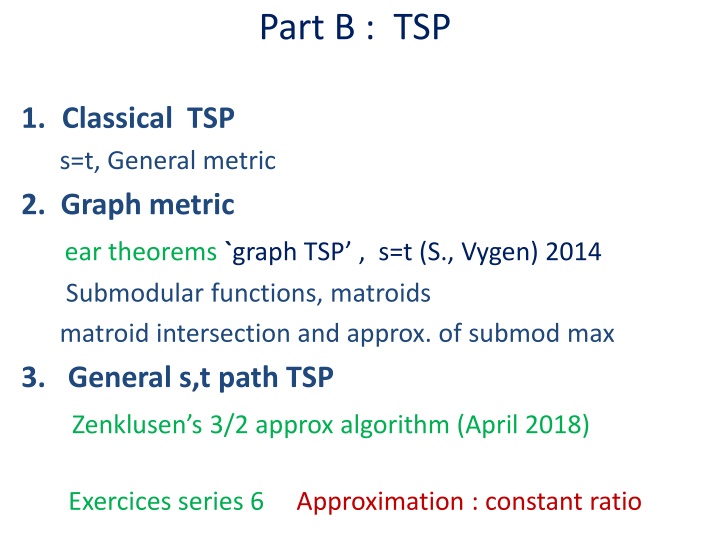
Traveling Salesman Problem: Approximation and Integrality Ratios
Explore the classical Traveling Salesman Problem (TSP), graph metrics, approximation ratios, integrality gaps, and famous conjectures in optimization theory with a focus on efficient solutions and mathematical insights.
Download Presentation

Please find below an Image/Link to download the presentation.
The content on the website is provided AS IS for your information and personal use only. It may not be sold, licensed, or shared on other websites without obtaining consent from the author. If you encounter any issues during the download, it is possible that the publisher has removed the file from their server.
You are allowed to download the files provided on this website for personal or commercial use, subject to the condition that they are used lawfully. All files are the property of their respective owners.
The content on the website is provided AS IS for your information and personal use only. It may not be sold, licensed, or shared on other websites without obtaining consent from the author.
E N D
Presentation Transcript
Part B : TSP 1. Classical TSP s=t, General metric 2. Graph metric ear theorems `graph TSP , s=t (S., Vygen) 2014 Submodular functions, matroids matroid intersection and approx. of submod max 3. General s,t path TSP Zenklusen s 3/2 approx algorithm (April 2018) Exercices series 6 Approximation : constant ratio
Optimal orders Metric: triangle inequality, satisfied by reasonnable applications, without it: even approx is hard TSP : s=t s-t-Path Travelling Salesman Problem INPUT : V cities , s , t V, c: V V IR+ metric OUTPUT: shortest s-t -Hamiltonian path OPT(c) P(V,s,t) = { x IR+E: x( (W)) 2, W V, s, t W or 1, if s,t separated by W s s t t = on vertices (1 for s, t ; else 2 )} min cTx t OPTLP(c)
Approximation and Integrality ratio For a minimization problem - the approximation ratio is at most if for any input a solution of value at most OPT can be found in polynomial time. - the integrality gap is at most if for any input OPT / OPTLP . Lower bound for integrality gap : graph metrics ... 2 1 k-1 1/2 ... 4 s 3 1 s=t 3 t 2 Lower bound for approximation ratio: 123/122 NP-hard (Karpinsky Lampis, Schmied) Famous Conjectures: integrality gap and approximation ratio 4 3 resp3 2
s=t Without it no constant ratio (easy from HAM) TSP INPUT : V cities, c: V V IR+ metric OUTPUT: shortest Hamiltonian circuit NP-hard (Karp, 1972) Christofides (1976) Determine: a minimum weight spanning tree Add : Add a minimum TF - join JF to make it Eulerian Shortcut the Eulerian tour
A proof of ratio 2 and two proofs of 3 2 Approximation ratio 2 : Double a min cost spanning tree F and shortcut. Approximation ratio3 connected, Eulerian has two disjoint T-joins for all T 2 : F + JF , where c(F) OPT , c(JF) 1 2 OPT, since OPTLP := {min c(x) : x IR+E, x( (W)) 2, for all W V, = for vertices} Theorem(Wolsey 80, Cunningham 1984) G=(V,E) graph. We find at most3 2 OPTLP since c(F) OPTLP , c(JF) 1 2 OPTLP Proof. x P: E[F] x , E[JF] x/2,; E[F + JF] = E[F] + E[JF ]
2. Classical TSP with graph metric, and min size Two-edge-connected spanning subgraph
Network reliability 2-Edge Connected Spanning Subgraph, 2ECSS graph-TSP, graph-TSP paths Minimum cardinality 2-edge-connected spanning subgraph . Def: A graph G=(V,E) is 2-edge-connected, if (V, E \ e ) is connected for all e E .
Ears G = P0 +P1 + P2 + + Pk P6 P3 P5 P7 P4 2-approx for 2ECSS: delete 1-ears! P8 P9 P1 P2 The longer the ears, the smaller the quotient n. of edges / vertices P0 Exploited by Cheriyan, S., Szigeti (1998) for a 17/12 -approx
Matroids C = (S, F) , F P(S) is a matroid if (i) F (ii) F F, F F F F (iii) F1 ,F2 F ,|F1|< |F2| e F2\ F1 : F1 {e} F that is, F F F is called an independent set. The rank function of M is r : 2S IN defined as r(X):= max {|F| : F X, F F } Examples: Forests in graphs, Linearly independent sets , partition matr.
Matroid Intersection Theorem M = (S, F) matroid conv ( F : F F) = {x IRS : x (A) r(A) for all A S } (Edmonds) maximize { |F| : F F1 F2 } =? max { 1T x : x (A) ri (A) (i=1, 2) for all A S } Theorem (Edmonds 1979): max |F| = min r1 (X) + r2 (S \ X) F F1 F2 X S Polynomial algorithm for both and also if weights are given.
Matroid Intersection Algorithm Generalization of bipartite matching (of the alternating paths in the Hungarian method ) Proof of : that is, there is F and X with |F| = r1 (X) + r2 (S \ X) . We prove that the following algorithm terminates with such an F and X. What is the INPUT ? ORACLE - rank, independence, etc 0.) Let : F F1 F2 maximal by inclusion (greedily) C2 C2 1.) Define arcs from unique cycles : y x F C1 C1
Approx for submod max mon, size k, f(0)=0, Algorithm (for sets of size k): (Nemhauser, Wolsey) Having X already, WHILE |X|< k choose x that maximizes f(X {x}) - f(X) Lemma : f(X {x}) - f(X) ( f(OPT) f (X) ) /k Proof: Since mon: f(OPT) f(OPT U X) f(X) + k (f(X {x}) - f(X) ) Let Xi be what we found until step i. Then f(Xk) - f(Xk-1) f(OPT) / k - f(Xk-1) / k, so f(Xk) f(OPT) / k + (1 1/k) f(Xk-1) f(Xk) f(OPT) (1 - (1 1/k) k) (1-1/e) f(OPT)
